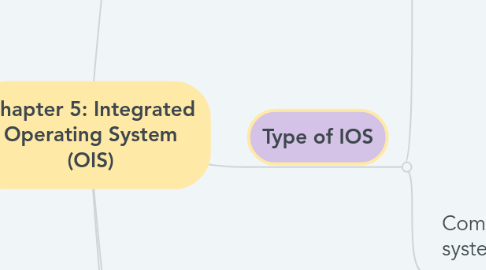
1. Major Characteristics
1.1. focus is on the main problem structure and processes of a specific industry
1.1.1. home insurance
1.1.2. family practice medical doctors
1.1.3. automobile manufacturers
1.2. addresses key decisions that need to be made to serve the customer in the best possible way
1.3. improve decision-making within the organization by:
1.3.1. data collection
1.3.2. data storage
1.3.3. dissemination of data
1.3.4. data analysis
2. Type of IOS
2.1. Supply chain management (SCM) systems
2.1.1. producing
2.1.1.1. the right product
2.1.1.2. in the right quantity
2.1.1.3. at the right time
2.1.1.4. in the right location
2.1.1.5. to the right customer
2.1.1.6. at the right price.
2.2. Computer-integrated manufacturing systems (CIMS)
2.2.1. represent the union of hardware, software, and communications to automate and control production activities
2.2.1.1. robot
2.2.1.1.1. programmable machine designed to handle materials or tools in the performance of a variety of tasks
2.2.1.2. CAD/CAE
2.2.1.2.1. enables engineers to design, analyze, test, simulate, and “manufacture” products before they physically exist.
2.2.1.3. CAM
2.2.1.3.1. involves computer control of the manufacturing process.
2.2.1.4. Flexible manufacturing systems (FMS)
2.2.1.4.1. consist of two or more computer-controlled machines linked by automated handling devices
2.2.1.5. Enterprise Resource Planning (ERP)
2.2.1.5.1. systems integrate all aspects of a business
2.2.1.5.2. unified information system and provide more timely analysis and reporting of sales
2.2.1.5.3. Two prominent vendors : SAP and Oracle.
2.2.1.6. Customer relationship management (CRM)
2.2.1.6.1. business strategy designed to learn more about customers’ wants and needs
2.2.1.6.2. behaviors in order to build customer relationships and loyalty and ultimately enhance revenues and profits
2.2.1.6.3. helps firms gain and maintain a competitive advantage by
2.2.1.7. Revenue management system (RMS)
2.2.1.7.1. dynamic methods to forecast demand
2.2.1.7.2. allocate perishable assets cross Rate classes,
2.2.1.7.3. decide when to overbook and by how much,
2.2.1.7.4. determine what price to Charge different customer (price) classes
2.2.1.7.5. Modern RMS software simultaneously makes changes in these decisions in a real-time operating system.
3. Benefits of Technology
3.1. Improves productivity and product quality
3.2. Creates new industries and job opportunities
3.3. Drives improvements in time, cost, and quality.
4. Making Technology Decisions
4.1. Scalability
4.1.1. measure of the contribution margin required to deliver a good or service as the business grows and volumes increase
4.2. High scalability
4.2.1. capability to serve additional customers at zero or extremely low incremental costs.
4.3. Low scalability
4.3.1. implies that serving additional customers requires high incremental variable costs
